Day in the Life of a Woman Historian: 1960s
What was it like to be a woman student of History at St Andrews in the 1960s? Taking inspiration from popular modern day ‘Day in the Life’ blog posts and YouTube videos, a group of current undergraduates explored personal papers, University Calendars, photographs, and records from the University’s Special Collections, to try to bring to life the experiences of women History undergraduates at St Andrews.
The sixties was an exciting decade. In the space of 10 years, the Beatles were formed and disbanded, John F Kennedy was assassinated, man landed on the moon, and more locally, the SNP won their first seat in the house of commons since 1945, marking the presence of Scottish nationalism on the political agenda of the country.
Change was afoot in St Andrews as well, especially towards the end of the decade. In 1967, the official partnership with Queen’s College Dundee came to an end, and the college was promoted to be an official university, the University of Dundee.
In 1969, the accommodation office made a dramatic move towards liberalisation. Students were allowed to have guests of either sex within their hall of residence, up until midnight. John Arnold, the then residences convener, stated that this change was ‘the beginning of a great change in the university’, which was ‘slowly ridding itself of a Victorian, paternalistic outlook’.
Linda Proom was an undergraduate history student at the University of St Andrews, graduating in 1963 with a second class in Mediaeval and Modern History. After her undergraduate, she continued to be involved in historical research, completing a PhD in Naval History, on the topic ‘The Role of the English Navy 1336-48′.
The University archives hold a collection of her papers from the time she was a high school student, up to her early days as a researcher, and during the STEP project, we were able to access them, which allowed an insight into a day in the life of an undergraduate history student at St Andrews in the 1960s. The following article is based off the material found in those papers (ms39102).
Morning
The morning would have started with waking up in university accommodation. People did still commute to the university, but there were now plenty of options for the students to stay in the town while studying.
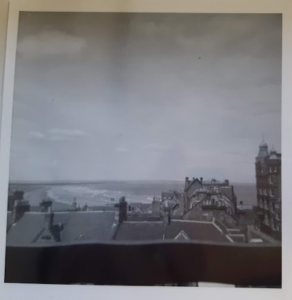
In 1896, University Hall was opened, the first residence for women students in Scotland. By the sixties, there were three female specific accommodation (certain wings of University Hall, McIntosh Hall, and Abbotsford House), with nine being offered for the males. Abbotsford House was Linda Proom’s accommodation. Abbotsford House offered an ideal in town location, providing quick access to classes, shops and the beaches. In 1965, it costed £190 for a full year of board in a female hall of residence. This is significantly cheaper than accommodation costs in town today, and it was estimated in the University calendar for 1965, that accommodation for a three-year Arts course would cost £815 (equivalent to £15,138.12 by the Bank of England’s inflation calculator). It is still surprising to see that this amount would not even cover two months average rent nowadays.
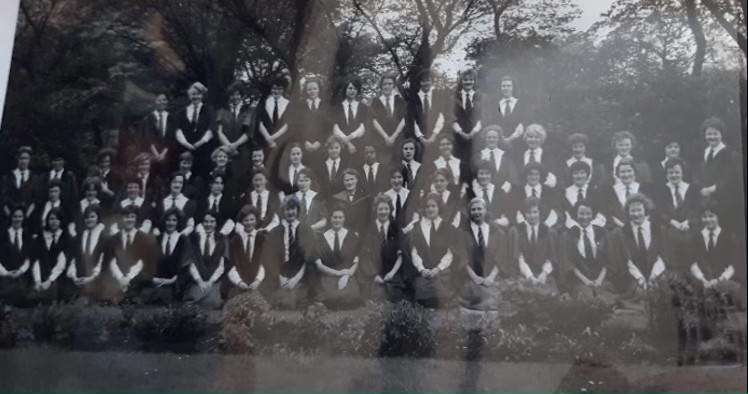
After getting up, students may have had a wander to the local shops. In Linda Prooms’ records, there was a very interesting item, a budget sheet of all her spending for an academic year (ms39102/3/2). Items purchased include entrance to dances, cakes, eggs, and membership of societies. Today, there are over 150 student run societies in town, and even in the 60s, there was a wide range of clubs that students could join. From Linda Proom’s papers, we know that she paid membership to the history society (no surprise there), the Anglican society and the Celtic society.
Afternoon
Unlike their friends in the mathematics department, who did (and still have!) 9am lectures, history students seemed to be allowed a bit more of a lie in in the morning. For example, from 1-3pm, there was a Junior Honours Mediaeval History class. The classes tended to meet around 4 times a week.
Coursework was set at multiple times of the year, as it still is today, and students had a choice about what questions they wanted to answer. An example question from the coursework in January 1962 is ‘Explain the unbroken success of the partition oligarchy in ruling the Venetian Republic in the fourteenth and fifteenth centuries’. An interesting thing of note looking through the papers was that feedback for the questions seemed to be given in Latin! This was perhaps not out of the ordinary, as in the 1965 University Calendar, the following requirement is stated:

The exam papers had an interesting range of questions. The exam period tended to be sometime around May, as it still is today. Below are some of the topics that the students were asked to write about in the exams.
Section A:
- ‘’The last of the mediaeval empires’. In what way did Charles V deserve this description?’
- ‘Analyse the cause of the weaknesses of the French monarchy in the period 1610-53’
- ‘Define Enlightened Despotism (Absolutism) and discuss on what terms Catherine II of Russia may be considered representative of this.
Section B:
- ‘In what main respects did the economic and social ideas prevalent in the seventeenth century differ from those in the middle ages’
Evening
After the classes of the day were finished, there was many ways students could unwind. As previously mentioned, the university offers a great number of societies that students can join. In Prooms’ papers, there was details of the events put on by the History, Archaeology and the Film societies.
The Archaeological Society met 8 times in 1960, offering a different speaker giving a talk in each session. The talks were held at 8.30pm in School I in the quad.
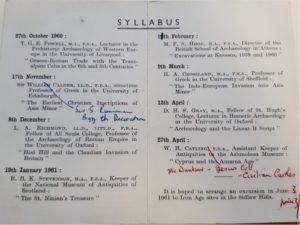
The film society only required a £1 subscription, but it was limited to 1000 members. The shows were held at 2.30pm and 8pm on Sunday, and all the films were shown at the New Picture House.
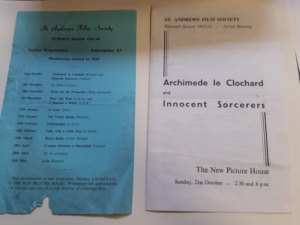
Based on the leaflets in the box, it is likely that Linda Proom at least made it to two of the screenings, seeing Archimede le Clochard and Innocent Sorcerers.
In 1960, the History Society held 7 talks, and had plans for a weekend reading party at the Burn, the location that is still used today for schools to hold their reading parties. Note the complete lack of female representation in any of the talks, talkers or committee shown in the History Society leaflet.
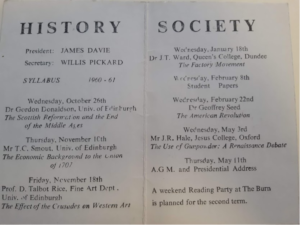
An unwavering staple of student life must be the parties. Based on the number of
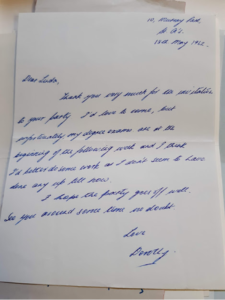
invitations, and RSVPs in the papers of Linda Proom, it was clearly a popular activity to spend your weekend partying with friends. On Saturday May 26th, 1962, Linda Proom hosted a party of her own. It was held in the Women’s Student Union library (they were still separate male and female student unions at this point). This was not her only party, as on the 6th of June there was another, with all the guests signing the tablecloth (ms39102/4/5/1/1/3) from the party. The parties were a bit more formal than they are today, with the people invited sending physical RSVPs to Linda, and she kept a collection of all of them.
The day is now over, and the students would have returned to their accommodation, ready to continue their studies and social life the next day.
This is just one of the blogs in a series of ‘days in the life’ from various decades. If you’ve enjoyed this post, please check out the other decades: 1930s, 1980s, today.
For some further reading of what it was like to be a student in the 1960s, please check out this blog post from Aileen Fyfe on studying history in 1965.
